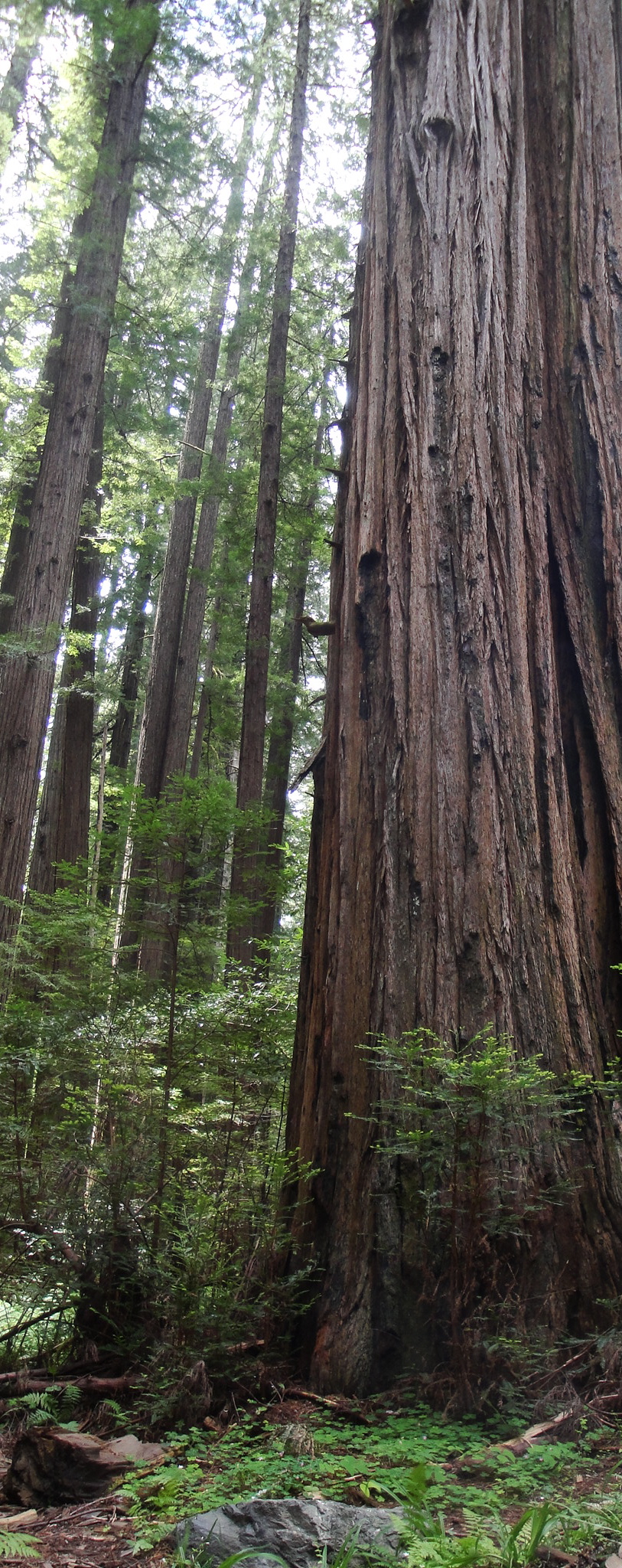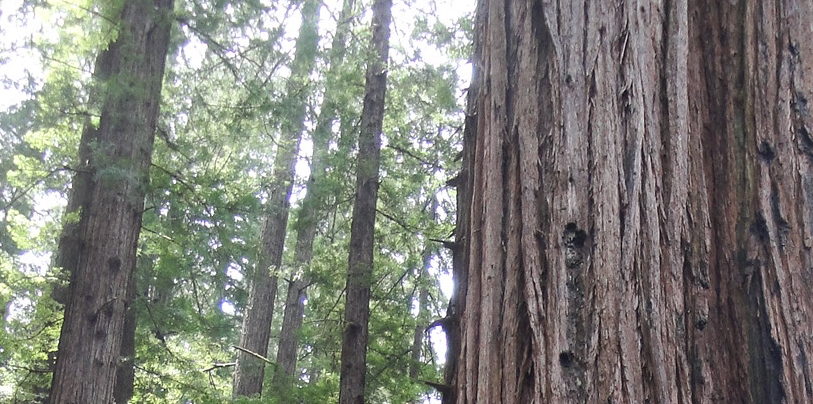Coastal Redwoods
~ the tallest trees in the world ~
 Throughout Armstrong Redwoods State Natural Reserve, visitors find an abundance of coast redwoods, Sequoia sempervirens. These trees are exclusively found along the western coast of the United States, being endemic to California however they can also be found in southern Oregon. Their northern most range lies in Southern Oregon and proceeds south along the California coastline ending around the Santa Cruz area. They do not grow much further north because it is too cold and beyond Santa Cruz it is too dry. The eastern limit of their range is not far from the coast, ending at the eastern extreme of the fog range. Beyond where fog is typically found, the environment dramatically increases in temperature and drops in moisture. Redwoods are not drought tolerant, they thrive where there is water and fog, so central and eastern California is simply too hot and dry of an environment. To the west, redwoods are found a few miles inland from the coast, a safe distance away from the salty coastal environment. Being too far west can result in salt burn; salt from both ocean spray and coastal air collects and builds up on nearby soils and leaves. An excess of salt can retard plant growth and inhibit seed germination, making this a difficult environment for redwoods to thrive. These are the various factors limiting the geographic distribution of redwoods.
Throughout Armstrong Redwoods State Natural Reserve, visitors find an abundance of coast redwoods, Sequoia sempervirens. These trees are exclusively found along the western coast of the United States, being endemic to California however they can also be found in southern Oregon. Their northern most range lies in Southern Oregon and proceeds south along the California coastline ending around the Santa Cruz area. They do not grow much further north because it is too cold and beyond Santa Cruz it is too dry. The eastern limit of their range is not far from the coast, ending at the eastern extreme of the fog range. Beyond where fog is typically found, the environment dramatically increases in temperature and drops in moisture. Redwoods are not drought tolerant, they thrive where there is water and fog, so central and eastern California is simply too hot and dry of an environment. To the west, redwoods are found a few miles inland from the coast, a safe distance away from the salty coastal environment. Being too far west can result in salt burn; salt from both ocean spray and coastal air collects and builds up on nearby soils and leaves. An excess of salt can retard plant growth and inhibit seed germination, making this a difficult environment for redwoods to thrive. These are the various factors limiting the geographic distribution of redwoods.
Fog is essential to the survival of coast redwoods, it provides moisture that is important to these mammoth organisms. Here in California, fog is heaviest during our early summer months, June and July. This works perfectly for redwoods since there is barely any rainfall during this dry period, the fog is basically the only source of water and is able to provide enough necessary moisture to sustain them until the rainy season begins. This lends more evidence to explain the geographic limitations of redwoods, since only locations that receive fog will have enough moisture during the dry season to feed these immense trees.
There are a few ways in which fog can form; during the dry summer months in California the process is driven by a change in wind direction. Warm air from the interior of the state blows out to the coast, this warm air then becomes cooled from the surface of cold ocean water. The water molecules within the air mass are now cooled and begin to condense. The condensation forms fog, a low-lying mass of condensed water vapor. This is called advection fog, and commonly occurs in conjunction with marine upwelling along the California coast. Upwelling is a oceanic occurrence driven by wind, in which the warmer surface waters are pushed out and replaced by cold, more nutrient-rich waters rising up from below.
One adaptation of redwoods that allows them to utilize fog is their leaf structure. Redwoods have needles, the leaves in their upper canopy are of a different structure than their lower leaves. In the upper reaches, the needles are tightly bunched together, so they can absorb moisture and excess moisture will drip off, falling either on lower needles or down to the forest floor to be absorbed by their roots or understory plants. While the needles on the lower branches are positioned opposite each other, to create a larger, flatter surface allowing for condensation of water. Their leaf shape, the needles, also allow redwoods to retain more water than if they had broadleaves. Especially the tightly compressed needles in the upper canopy, these are geared towards water absorption and minimizing water loss. Since there are not many other trees to compete with for sunlight at that elevation, it is more about water retention than sun exposure. Additionally, the sheer height of redwoods ensures that they have maximum exposure when fog rolls in, increasing the potential for water absorption.
